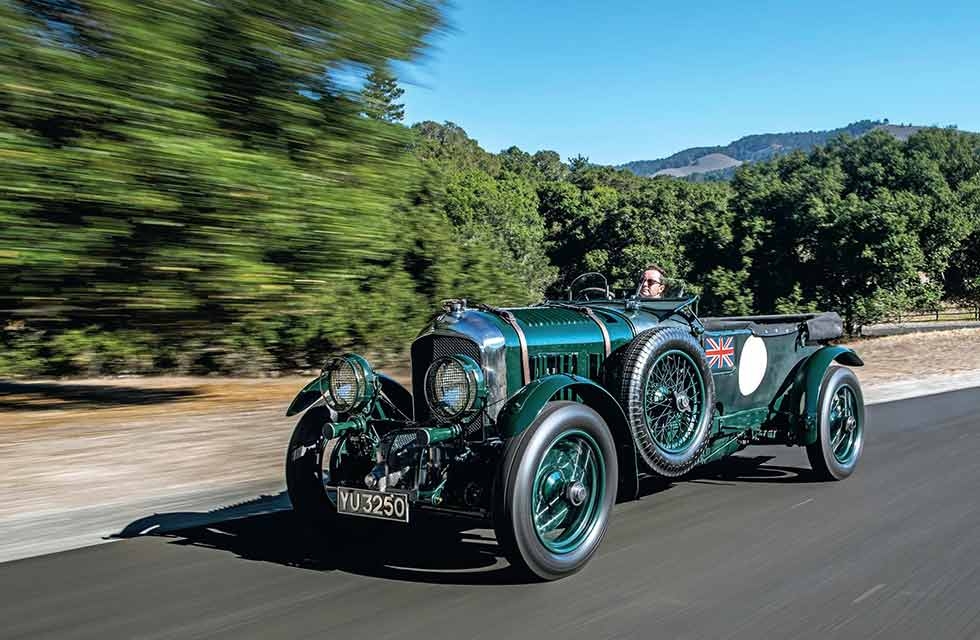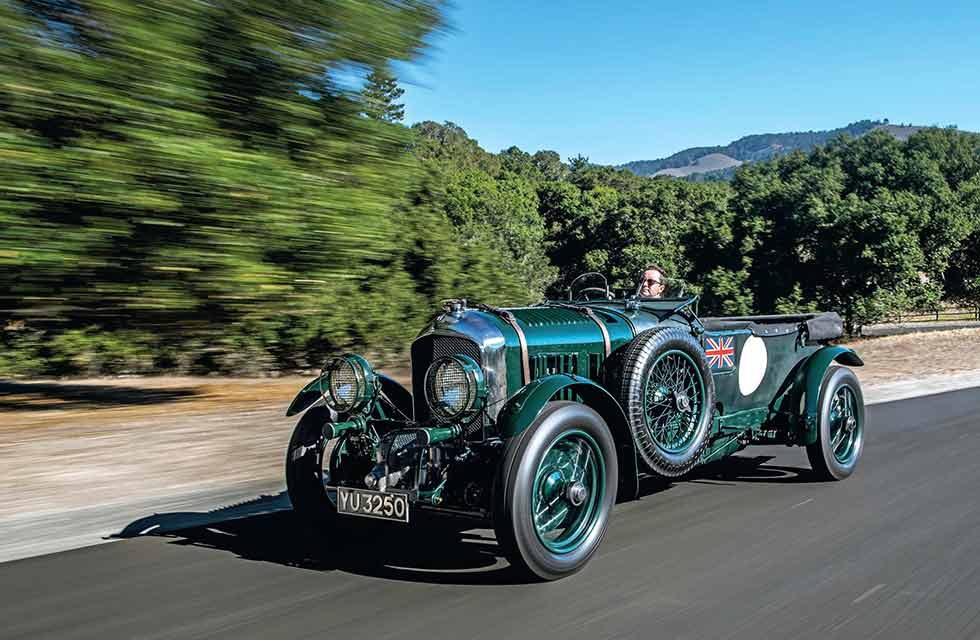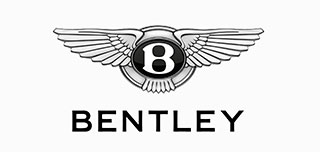
Landing the first blow. An exclusive drive in the original ‘Blower’ Bentley, the first produced by Henry ‘Tim’ Birkin… Words James Mitchell. Photography Drew Phillips/Clare Hay Archive.
BENTLEY’S CENTENARY
From Cricklewood to Crewe, fierce independence to a key part of the VW empire, Bentley has retained a unique charisma. Here’s our tribute to 100 years of British beef.
Their early lives were as different as the cars they built. WO Bentley was brought up in suburban north London and worked to fund his motorcycle racing before taking on the UK concession for French car manufacturer DFP; Sir Henry Ralph Stanley ‘Tim’ Birkin, 3rd Baronet, was born into a wealthy aristocratic family with no immediate pressure to earn a living. But they were brought together, along with millions of other young men and women, as a result of the ultimate social leveller, The Great War.
BENTLEY AT 100 / DRIVING THE FIRST ‘BLOWER’ Exclusive blast on California roads in the magnificent, pioneering YU 3250
Celebrating a century of success, from ‘Blower’ to bargains, luxury to LeMans
‘The car today is much as it was when it went to Le Mans in 1930, the great protruding supercharger reminding everyone that this is no ordinary vintage Bentley’

This was the real foundation of the whole Bentley escapade, the building blocks for almost every character in the marque’s early years. WO designed what was then Britain’s most successful aero engine, and from the spoils of war he founded Bentley Motors Ltd. Soon there were names such as Clement, Duff, Benjafield, Davis, Kensington Moir, Barnato, Birkin and Kidston – fresh from battle, many had first-hand experience of either fighting in the trenches or on the frontline of engineering development. There’s nothing like a war for technological progress.
From those early Cricklewood days, WO built sports cars that were as dependable as his aircraft engines; cars that could be driven, and raced, for long periods of time. Success was found at Indianapolis, in the Tourist Trophy, at Brooklands and eventually at Le Mans. However by the 1928 German Grand Prix at the Nürburgring in July, an event from which Bentley Motors had controversially withdrawn its official three-car team, Birkin simply couldn’t keep up with the supercharged Mercedes. Many felt that Bentley was at a critical point; without development, the firm was in danger of losing its place at the head of the motor-racing pack. Birkin was a talented engineer in his own right, developing the Birkin-Comery engine and conducting experimental work on ACs and Aston Martins, most of which was in collaboration with Amherst Villiers. They believed the excellence of Bentley could be further improved, so, with cautious support from the factory, decided to supercharge the 4½ Litre. WO was not convinced by supercharging, but agreed to the plan because Birkin was to finance it independently.
‘With upgrades, serious backing and one of the three cars running as a single-seater, the full might was finally revealed’
Bentley Motors, meanwhile, continued developing the Speed Six as a race car. The story of this first ‘Blower’ Bentley, YU 3250, represents the two faces of the WO Bentley and Tim Birkin story perfectly, for its life started before Birkin and his Blowers. Company chairman Woolf Barnato had decided during the winter of 1927/’1928 that it was essential to field a team of three factory cars at Le Mans. Knowing that this was a strong possibility, Birkin and Bernard Rubin each ordered a 4½ Litre to secure their places in the unofficial ‘Bentley Boys’ club. Rubin’s car was to be registered YU 3250 and ordered to Le Mans specification, with a 25-gallon petrol tank and close-ratio A-type ’box. The order for the Vanden Plas body was unusually specific, and very similar to that of the 1927 Le Mans entry known as Old Mother Gun.
Five weeks before venturing to La Sarthe, Bentley Motors thought it prudent to give the works cars a shakedown at Brooklands. They were one short, so YU 3250 was pressed into service and Rubin shared the car with Dr Dudley Benjafield for the 2.616-mile handicap, finishing sixth without any reliability issues.
To run a blown Bentley at Le Mans, Birkin needed to build 50 cars at his Welwyn Garden City workshops. Before he could get going on a ‘production’ car, however, he needed to test the theory on a handful of prototypes. The agreement with Bentley Motors was that Villiers would design and supply an initial batch of test superchargers, and Bentley would pay him a royalty on each one if it decided to standardise the concept. Villiers was sceptical about the team Birkin had around him – he called engine designer Clive Gallop a “hot-air technician who’d probably never handled a hacksaw” – but took on the challenge.
Birkin had his own 4½ Litre, but in 1929 he secured YU 3250 for the installation of the first of the three supplied superchargers. Fitting the supercharger was easy; keeping it alive and well wasn’t. Development work was constant and fast-paced, improving oil flow, cooling and lubrication with every road test. Gallop later admitted that during this development work quite a few mistakes were made.
The first outing for the supercharged YU 3250 was supposed to be the 1929 Brooklands Double Twelve, but it managed only practice. Returning to Welwyn, work continued in earnest but the assault on Le Mans had to be ’box. The order for the Vanden Plas body was unusually specific, and very similar to that of the 1927 Le Mans entry known as Old Mother Gun. Five weeks before venturing to La Sarthe, Bentley Motors thought it prudent to give the works cars a shakedown at Brooklands. They were one short, so YU 3250 was pressed into service and Rubin shared the car with Dr Dudley Benjafield for the 2.616-mile handicap, finishing sixth without any reliability issues.
‘Stepping on the footplate on the passenger side, the small, flimsy door is the easiest way in. The leather is old and worn, the floorboards are bare, with a heel-worn groove below the throttle’
To run a blown Bentley at Le Mans, Birkin needed to build 50 cars at his Welwyn Garden City workshops. Before he could get going on a ‘production’ car, however, he needed to test the theory on a handful of prototypes. The agreement with Bentley Motors was that Villiers would design and supply an initial batch of test superchargers, and Bentley would pay him a royalty on each one if it decided to standardise the concept. Villiers was sceptical about the team Birkin had around him – he called engine designer Clive Gallop a “hot-air technician who’d probably never handled a hacksaw” – but took on the challenge.
Birkin had his own 4½ Litre, but in 1929 he secured YU 3250 for the installation of the first of the three supplied superchargers. Fitting the supercharger was easy; keeping it alive and well wasn’t. Development work was constant and fast-paced, improving oil flow, cooling and lubrication with every road test. Gallop later admitted that during this development work quite a few mistakes were made.
The first outing for the supercharged YU 3250 was supposed to be the 1929 Brooklands Double Twelve, but it managed only practice. Returning to Welwyn, work continued in earnest but the assault on Le Mans had to be postponed due to technical issues. Little period correspondence between Bentley Motors and Birkin survives, but it seems that initially Cricklwood wasn’t as helpful as it could have been. The factory’s focus was no doubt on its own cars, which paid dividends when it romped home in first, second, third and fourth place at Le Mans. YU 3250’s next outing was at the Tourist Trophy in Belfast in August. Three supercharged cars were entered: Rubin rolled, YU 3250 retired and Birkin finished 11th.
Two things happened that winter: Birkin set about rectifying the season’s teething troubles, and the team found funding in the form of the immensely well-off Honourable Dorothy Paget. This injection of money meant all three cars could be rebuilt and ensured production of the road car could begin. It was at this point that the standard 4½ of Bentley Motors began to really differ from a Birkin Blower, with the latter incorporating lighter materials, reinforced components and applying almost wholesale everything learned in several years of racing. The 1930 season started very differently.
With the upgrades, serious backing and one of the three cars now running as a single-seater, the full might of the Blower Bentley was revealed. At the Brooklands Easter meeting, Birkin repeatedly attacked the lap records and had to be re-handicapped throughout the weekend. But it was the Brooklands Double Twelve that proved the real test, in which three of the Blowers were to compete – YU 3250 was to be driven by Glen Kidston and Jack Dunfee.
The regulations put the supercharged 4½ in the same class as the Speed Six, pitching the Birkin cars directly against the factory machines. Practice started well, with Birkin’s car lapping considerably faster than the Alfa Romeo had the year before on the way to victory. The race was led by a cluster of blown and unblown Bentleys, with YU 3250 ahead of a brace of Speed Sixes, but the Blowers’ speed steadily diminished. By 3pm on the first day YU 3250 was out of the race with a cracked valve; Birkin followed soon after with a cracked chassis, and the remaining Blower suffered from rear axle trouble the following day. Speed Sixes claimed first and second place.
This was ultimately a dress rehearsal for Le Mans, and a huge amount of preparation had gone into readying the three Blowers, with Jack Dunfee and Beris Harcourt-Wood driving YU 3250. Further changes were made from the Brooklands set-up, including the addition of Ziess headlamps and extra bracing bars. Birkin made a bad fuel choice for practice, so WO sent over some of his mechanics to assist.
Following an unguarded comment from one of the Mercedes drivers to Bentley racer and journalist Sammy Davis about how stressed their engines were when the supercharger was engaged, it was decided that Birkin and WO would work as one six-car team for the greater good. Birkin was to put pressure on the Mercedes from the off and push them to breaking point. This almost certainly meant sacrificing his own car, but it seems that a sense of national pride won him over. It worked, with a Speed Six coming home in first and second, but at a great cost to the Blower programme and none finished. YU 3250 didn’t even make the start – the reason why is not known.
Bentley withdrew from competitive motorsport after the race, leaving Birkin and his Blowers to fly the flag – starting at the Irish Grand Prix. Of the three cars entered, YU 3250 would be driven by Harcourt-Wood. The Mercedes of Rudolf Caracciola was the main threat and he was unstoppable when it started to rain. All three Blowers had mechanical ailments, but Birkin eventually finished fourth overall. YU 3250’s send-off came at the Tourist Trophy, where it was driven by Kensington Moir and finished 11th overall. It was the only Paget car to finish. But while other Blowers continued to race through the season, YU 3250 was retired from the frontline of the programme.
Following the withdrawal of Paget’s backing, the three Birkin Blowers were to be sold. YU 3250 was bought in 1932 by CJ Turner, a privateer who continued to race it at Brooklands. He was considered a bit of a daredevil, on one occasion dipping two wheels over the edge of the banking for 200 yards while passing another car. Former Brooklands racer Harry Rose saved YU 3250 in 1957 from an uncertain future and restored the car. It was no trailer queen, covering a kilometre at 124.3mph during an Antwerp speed trial in 1965. He toured all over the world, and in the late 1960s it was made into a Scalextric model and jostled for position as the most famous car in the world. It was inherited and raced by his daughter Ann Shoosmith, who eventually sold it to watchmaker extraordinaire George Daniels before the current owner secured the historic machine in 1995.
The car today is much as it was when it went to Le Mans in 1930. We’re not on home turf and, like France in June, it is hot and dry, the heat from the Tarmac swirling around our ankles. The great protruding supercharger reminds everyone that this is no ordinary vintage Bentley, but one of the great Blowers. Stepping on the footplate on the passenger side, the small, flimsy door is the easiest way in. The leather is old and worn, and the aluminium of the dash perfectly contrasts the large, black-faced gauges with clear white numerals. The floorboards are bare, with a heel-worn groove below the central throttle. The brief, high-pitched call of the starter is cut short by the near-instant reply of the engine, immediately settling into that familiar ‘bloody thump’. Everything is chunky, from the steering wheel to the right-hand gearlever. Pulling away is easy, the huge flywheel needing almost no revs. With a firm, decisive hand to change up through the gears, we’re soon bombing along. The view is of an aeroscreen, ahead of that the fold-flat windscreen and long, louvred bonnet. The torque is astonishing; the roads undulate, and with every incline there is no change of pace. The thump just keeps thumping, eating up the road. Once moving, the steering is no heavier than many post-war saloons, the length of the chassis and the sheer weight ensuring an impressive sense of stability unlike any other Bentley 4½ Litre you’ll come across.
Out on the roads for a couple of hours, the relentless California sun skips brightly around the chrome radiator until all excuses for staying out any longer are exhausted. How a car such as this could be driven, at speed and in this heat, for 24 hours almost beggars belief.
This is not just the story of a single car, but rather the two contrasting supercharged dreams of Bentley and Birkin. The early escapades of Bentley Motors Ltd had captured the imagination of a nation, shattered records and earned national pride. Birkin built on these foundations with a roll-call of characters right out of a Boy’s Own comic, and ensured that YU 3250 and its blown brethren became national icons.
Top: Harcourt-Wood investigates engine problems during the 1930 Irish Grand Prix. Below: right-hand gearlever with wheel to adjust brake linkages on the go. Bottom: the position of the Villiers’ supercharger meant front tyres suffered, so Birkin later shortened the chassis to alleviate this. Top: the mesh windscreen, folded flat, is lost against the long bonnet. Below: the bottom end was from the 3 Litre engine, combined with the bore and stroke of the 61/2 Litre (100mm x 140mm) to hit 130bhp in pre-supercharged Le Mans specification. Kensington Moir ahead of the Alfa Romeo 6C of opera singer and runner-up Giuseppe Campari in the 1930 Tourist Trophy. As in 1929, only one Blower finished – both times 11th.
Clockwise from left: Jack Dunfee (seated) and Beris Harcourt-Wood post-scrutineering at Le Mans in 1930; YU 3250 glides along; machined aluminium dash denotes a racer, road cars featured wooden dash – some had a countdown clock for longer races, too.
BENTLEY 4 ½ LITRE ‘BLOWER’
Sold/number built 1929-’1931/55, including five special team cars
Construction steel ladder-frame chassis, timber body frame with leather-covered aluminium panels
Engine cast-iron block and head with Elektron crankcase, sohc 4398cc ‘four’, four valves per cylinder, fed by two SU carburettors with Amherst Villiers Roots-type supercharger
Max power 175bhp @ 3500rpm (team cars c240bhp)
Max torque 325lb ft @ 1800rpm (team cars c400b ft)
Transmission four-speed manual, RWD
Suspension: front H-section beam axle rear live axle; semi-elliptic leaf springs and friction dampers f/r (twin dampers at rear)
Steering worm and wheel
Brakes mechanically operated 15 ½ in (400mm) drums with Perrot shafts
Wheels & tyres 21in steel spoked wheels with 6.00 x 21 crossplies
Length 14ft 4 ½ in (4380mm)
Width 5ft 8 ½ in (1740mm)
Height 5ft 3in (1600mm)
Wheelbase 10ft 10in (3302mm)
Weight 3800lb (1725kg)
0-60mph c12 secs
Top speed 125mph
Mpg n/a
Price new £1720 (1927, chassis only)
Price now $15m






